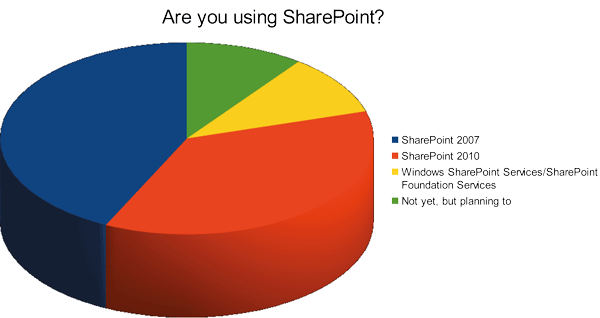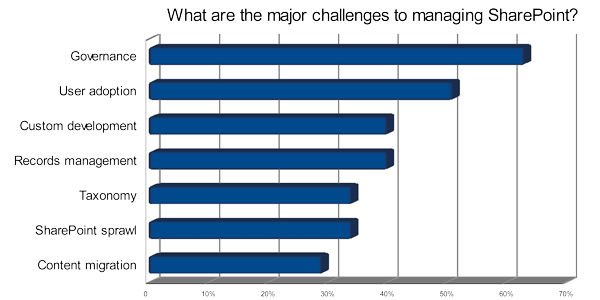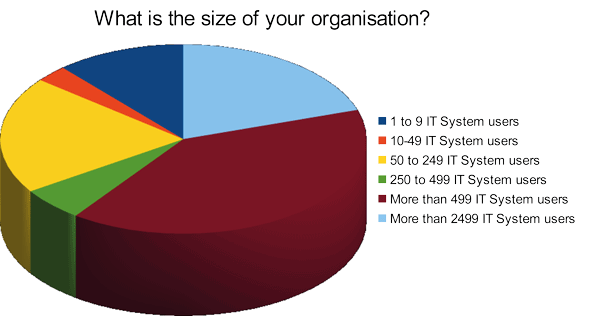2012 SharePoint Survey showcases governance concerns

Governance, Tick. User adoption, double tick. Custom development and records management, tick again. IDM’s 2012 survey of knowledge and information managers has found some common concerns as they undertake SharePoint upgrades or fresh deployments across Australia and New Zealand.
 Whether in tandem with an existing EDRMS or increasingly as a solo ECM endeavour, SharePoint usage is mushrooming across government organisations.
Whether in tandem with an existing EDRMS or increasingly as a solo ECM endeavour, SharePoint usage is mushrooming across government organisations.
More than 150 organisations responded to the IDM survey, providing a broad sample of vertical markets across government, education, utilities, health, mining and a range of other sectors. Around half of the organisations that responded to the survey are still using 2007 while the bulk of the others have upgraded or installed SharePoint 2010.

Many organisations know information governance is something they should have a handle on but few are actually addressing the pressing need to manage their data better.
Information governance incorporates a range of different disciplines, managing e-mail/records retention, securing reliable and secure data storage, and enabling regulatory compliance and ediscovery readiness.
Melanie Rogers, ICT Information Manager at Life Without Barriers, is embarking on a SharePoint rollout at the NSW-based secular, non-profit organisation.
“People are excited and keen to use SharePoint collaboration. Unfortunately their enthusiasm outweighs our governance requirements / technology at present.
Engaged in helping children and people living with a disability and metal health issues, Life Without Barriers runs 85 support centres with workforce of over 3000.
Rogers recommends those undertaking adoption “Try to plan the SharePoint deployment as a project. Governance is key, as is an idea about what the end game plan should look like.”

Governance threat
"Gartner predicts that By 2016, 20 per cent of CIOs in regulated industries will lose their jobs for failing to implement the discipline of information governance successfully.
"We've seen rapidly growing interest in information governance-related topics, and this trend shows no sign of abating," said Debra Logan, vice president and distinguished analyst at Gartner. "Information governance is the only way to comply with regulations, both current and future, and responsibility for it lies with the CIO and the chief legal officer. When organisations suffer high-profile data losses, especially involving violations of the privacy of citizens or consumers, they suffer serious reputational damage and often incur fines or other sanctions. IT leaders will have to take at least part of the blame for these incidents."
In 2012, Gartner recommends highly regulated businesses that do not already have information-archiving technology should invest in it in order to bring email and files under control. The governance-related technology of information archiving has reached early majority and is a key component of an evolving information governance technology strategy.
Through 2016, Gartner believes spending on governing information must increase to five times the current level to be successful.

Defence HQJOC
SharePoint 2007 is providing collaboration and workflow at the Australian Defence Department’s Head Quarters Joint Operations Command facility in Bungendore, NSW.
The $500 million purpose-built facility is located about 25km east of Canberra. It was opened in 2009 and houses over 550 staff from all the defence forces, Army Navy and Air Force. It serves as the headquarters for all theatres of operations worldwide, including Afghanistan, Iraq and border protection in northern Australia.
SharePoint 2007 is used in addition to the Objective ECM platform, with applications in business process management, as a metadata repository and digital object reposition (MDMM).
Duncan Jamieson, Director, Command Information Management at HQJOC, says the rollout includes SharePoint TeamSites, and it had changed the way staff collaborates for the better, delivering reduced email traffic and attachments.
Jamieson recommends “spend time planning and more planning” to get the governance right.
“Your priority is to get an information architecture and taxonomy linked to business process management.
“Think about the basic services being provided and how staff can be more productive rather than introduce the ‘bells and whistles.’
Document scanning is incorporated with the SharePoint deployment at HQJOC as manual processes are seen as a negative impact on productivity.
“Having multi-step processes increases the risk of documents not being entered into SharePoint. Secondly, we have an increased risk of users not applying OCR to scanned documents.”
Defence was one of the few organisations surveyed to prioritise paperless workflow. Less than 15% of the submissions had integrated document capture with their SharePoint deployment.

Melbourneit
Matt Piper is Team Lead - Microsoft Hosting at Melbourneit, where nearly 700 employees are spread across 18 offices in 10 countries. Piper recommends ensuring Governance is prioritised from the outset.
“Make sure that for each business unit/division there are nominated champions who can be trained as power users so that teams can quickly get real benefit out of SharePoint.
“Also make use of SharePoint Saturday sessions, and localised training/user groups.
Make sure that any innovations are championed and advertised so that others can see what can be achieved and they can relate back to their own challenges.”
The recent global financial crisis has put information governance in the spotlight," according to Ted Friedman, vice president and analyst at Gartner. "Information governance is a priority of IT and business leaders as a result of various pressures, including regulatory compliance mandates and the urgent need for improved decision-making."
During the next few years, he estimates information governance initiatives will broaden significantly to include more sub disciplines - information quality, lifecycle management/retention, privacy and security - and more of the organisation's critical data. More people will have to be assigned to information governance, both in dedicated roles (such as information architect and data analyst) and as part-time contributors (such as stakeholders participating in information governance councils and data stewards).
"Regardless of the structure, information governance responsibilities will become part of the roles of more people, and the time and funding allocated to these roles will need to increase dramatically in the typical organisation," said Mr Friedman.
"Organisations will have to increase their investment in related tools and technologies, both to facilitate the development and refinement of policy, and to distil policies into executable rules that tools can apply to information.”
Reliability of data, security of data and are crucial to Information governance which also needs to ensure consistent naming conventions for data.

New views
Staff must be come used to a new way of thinking from the traditional network drive structure, notes Peter Duncombe, Information Management Specialist at City of Whittlesea, a local government body in Victoria.
“Information is out there, in front of staff, they need to go trawling for documents at time in a messy folder structure. But the benefits of Lists are becoming more evident also.”
The Australian Communications and Media Authority (ACMA) is using third party tools to manage with aspects of its SharePoint 2010 deployment, Axceler ControlPoint to handle governance and has RecordPoint to deliver records management compliance.
Deputy CIO Stephen Bounds believes in minimising customisation of a SharePoint environment.
“Purchase third party commercial off the shelf (COTS) solutions where possible to minimise code incompatibilities and maximise maintainability.”
SharePoint is the sole ECM platform for 50% of the organisations surveyed, while half use the Microsoft platform in tandem with another EDRMS vendor.
On the positive front, SharePoint is changing the way people communicate for the better.
Taline Babikian, Information Manager at Boral Cement, notes it’s important to “Be clear on the business requirements and asses SharePoint against them. If compromises on functionally are being made, understand the Impacts.
“Ensure that you fully understand the culture and readiness of your users to take up the technology and very importantly any changes to their work process or habits. There are a raft of business issues that emerge when this type of change is being introduced, e.g. - do users know what it really means to work within an IM governance framework? Do they understand the impacts of working with a taxonomy?
“Ensure your senior management and executive level champions are on board by action not just verbally expressing support.
